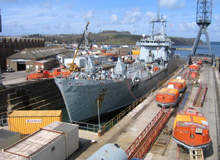
When defence budgets get cut, buying new vessels is generally seen as an unaffordbale expenditure. Refurbished and modernised second-hand ships seem to be a cost effective alternative. Many navies undertake large-scale sustainment efforts on ageing, yet still valuable naval assets, postponing the need for new construction and ultimately saving the taxpayer money.
US Navy modernisation program
At the moment the US Navy is undertaking the most comprehensive upgrade and modernisation program in its history to sustain, modernise and increase their capabilities. The vessels in question are the US Navy’s Ticonderoga (CG 47) class cruisers and Arleigh Burke (DDG 51) class destroyers, currently the backbone of the US Navy, comprising almost a third of the entire fleet.
Under the program, which began in 2009, the cruisers are currently receiving complete combat systems (CS) and hull, mechanical and electrical (HM&E) modernisation to ensure they are able to reach their projected 35-year service lives. This includes the new Aegis Advanced Capability Build 08, which amongst other upgrades allows a mission extension, such as ballistic missile defence. The DDG 51 class will also receive a HM&E modernisation, including a fully integrated bridge and improved machinery control.
Another program is directed to extend the service lives of the US Navy’s LSD 41, LSD 49 and LHD 1 class amphibious ships. The first of the LSD 41 class USS Gunston Hall received several critical technology upgrades last year, including the replacement of obsolete or unsupported HM&E systems. New LSD mid-life installations are expected to significantly reduce maintenance and total ownership costs, support new system integration between the Navy and the Marine Corps, improve operational availability, and reduce sailor workload requirements.
Royal Naval refurbishment
Already between 2006 and 2009 the Royal Navy upgraded RFA Argus, to extend her operational life to 2020 and to convert the ship to reverse roles with a new primary role as a casualty receiving ship and the secondary task of acting as a helicopter training vessel.
The first part of the work was undertaken in 2006 with the balance being completed in 2009. This £37m project involved removing one of the ship’s two helicopter lifts and the complete strip-out, refurbishment and upgrade of all accommodation and communal areas.
New old ships
Besides prolonging or ensuring up-to-date capabilities for the rest of the service lives of own vessels by such extensive sustainment programmes, some navies have turned to buying old used ships with the idea of refitting them.
The Lithuanian Navy for instance, which already has one Ex-Royal Norwegian Navy Storm class fast patrol boat and three Ex-Royal Danish Navy’s patrol boats in its fleet, is now refurbishing two former Royal Navy vessels into service.
Ex-HMS Cottesmore and Ex-HMS Dulverton were originally built as mine countermeasure vessels, converted to patrol boats in 1997 for duties in Northern Ireland and decommissioned in 2005. They have since been refitted with full mine-hunting capabilites, which involved completely upgrading the ship’s command, control and weapons systems, the installation of new engines, as well as the installation of a new mine-hunting system using remotely operated underwater vehicles.
On behalf of Thales Naval British company A&P Goup Ltd. has been working on this task, which has a history of regenerating former MoD vessels. “As the Royal Navy and Royal Fleet Auxiliary accepts new warships and auxiliaries into the Fleet, older ships that still have a service life are potentially very attractive assets for overseas navies,” said Max Sothcott, Business Development Director, Defence, at A&P.
In 2009 the company had already overhauled the 137m-long Round Table class landing ship ex-RFA Sir Bedivere, which saw service in the Falklands War. Amongst others this included the main engines and associated fuel, air and hydraulic systems as well as increasing the accommodation capacity to 350 ship staff and troops. Now the vessel serves with the Brazilian Navy under the name Almirante Saboia.
In May 2010 the company was awarded the contract for the refitting of two Castle Class offshore patrol vessels for the Bangladesh Navy. The former HMS Leeds Castle and HMS Dumbarton Castle were overhauled in Newcastle, before being transferred to South Asia. This work package included the overhaul of each vessel’s twin main engines and a significant upgrade to the accommodation which doubled the ship’s company, as well as the recommissioning all ship systems that had been idle for five years.
“Former Royal Navy and RFA vessels are in considerable demand as a cost effective alternative to new build options,” said Sothcott. The statement with respect to the British market applies to many navies, especially as former members of the Warsaw Pact and new members of the Nato alliance have been keen to buy refurbished vessels second-hand from their new allies to westernise their fleets during earlier years.
The Bulgarian Navy for instance operates three former Wielingen class frigates and a Tripartiti class mine-hunter from the Belgian Navy. The Romanian Navy owns two former Type 22 Broadsword class frigates from the Royal Navy. The Polish Navy operates two former US Oliver Hazard Perry class frigates and four former Norwegian Koban class submarines.
The Latvian Navy has four former Norwegian Storm class fast patrol boats as well as four former Royal Netherlands Navy Tripartiti class mine-hunters in its service.
All this shows clearly that upgrading and refitting existing ships is not only viable, but is an area that is likely to expand in the future as budget constraints in many economies become more stringent.







